- FCL Coaches Corner
- Posts
- Coaches Corner: 11/09/25
Coaches Corner: 11/09/25
Transition offense tips - fast breaks, slow breaks, L breaks, flat breaks. 🥍

Happy Sunday, Coach.
Welcome back to FCL’s Coaches Corner. Where we dig into coaching lessons, share resources, and work to grow together. Every other Sunday, we distill ideas we’ve learned from great coaches across all sports, hoping to give you a few tools and thoughts you can bring back to your team.
Let’s dive in.
(Missed the last Coaches Corner? Catch up here.)
Matt Dunn & Deemer Class
VEO Cam 3 Black Friday Deal — Limited Offer

We’re celebrating Black Friday with Veo’s Veo Cam 3 offer:
👉 $500 off Veo Cam 3
👉 Free Player Spotlight / Live
Sign up here and redeem your offer: get.veo.co/lp/first-class-lacrosse
PS: If Veo Cam 3 is out of budget, there’s also 50% off Veo Go this month.
Read more in the link.
Today’s Menu Includes:
💼 Job Board: New Posting - Women’s Assistant HS Coach
🔦 Coach Spotlight: Tom Izzo
🧠 Some Outside Inspiration: The Hard Hat: 21 Ways to Be a Great Teammate
🤓 A Trip to the Principles Office: Transition Offense
🔥 A Webinar Freebie: Jake Bernhardt - Tank Drill
💼 Job Board: Oak Knoll School
Shared through our FCL Premium Community Job Board, one of the perks for members is we help promote their openings to our full Coaches Corner network.
Position: Assistant Varsity Girls Lacrosse Coach
Location: Summit, New Jersey
Season: March through early June
Ideal Availability: 6 days per week
Preferred Experience: Playing and/or coaching
Oak Knoll School of the Holy Child is an independent Catholic school for girls in grades 7–12. The program is seeking a dedicated coach to help lead a talented group striving for national recognition in the 2026 season.
🔗 Apply here: https://oks.formstack.com/forms/employment
🔦 Coach Spotlight
Tom Izzo - Michigan State Men’s Basketball Head Coach
"Someone would say, well if you grab a kid or yell at him, that’s not respecting them. I look at it the opposite. I think discipline is the greatest form of love you can show somebody. It'd be easy for me to let the kid do what he wants. That's an easy road, but if you challenge him, the only way you can change them is to spend time with them and you've really done them a favor."
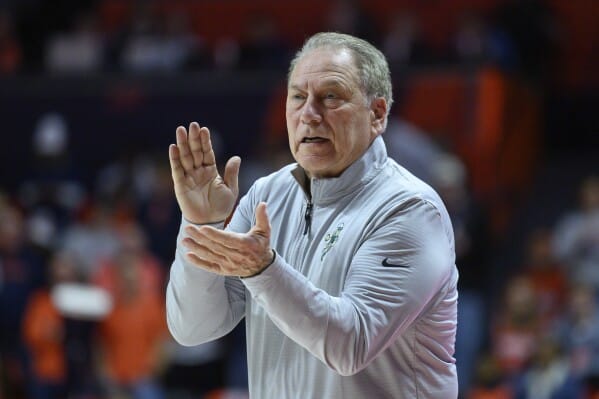
In an interview with Coach Izzo, Graham Bensinger asks what purpose yelling at players serves? Coach Izzo doesn’t yell at players as a result of one play. When he does blow up, it comes from a place of love.
Relationships are fundamental to Coach Izzo’s philosophy.
Mateen Cleaves, one of Coach Izzo’s former players, says that Coach Izzo held them highly accountable, but the players always knew that he cared about them.
Coach Izzo alludes to a sort of balance: If you care about your players and you want them the be great, you need to hold them accountable. In order to do that successfully, you must develop strong relationships with every player.
Through time spent with each individual player, you learn how to hold them accountable. They get to know you in and out, and you get to know them.
Through building these relationships, you reach a place where you can yell at players, you can be tough on them, and they understand it’s because you believe in them.
Discipline becomes a form of love, and accountability becomes a form of respect. The best coaches don’t yell out of anger, they demand out of belief.
🧠 Outside Inspiration
The Hard Hat by Jon Gordon

Jon Gordon’s The Hard Hat: 21 Ways to Be a Great Teammate tells the true story of George Boiardi, a selfless Cornell lacrosse player whose legacy continues to inspire athletes and teams everywhere.
It explores what it truly means to put the team first, to bring positive energy, selflessness, and toughness to every moment, on and off the field.
Through 21 practical lessons, Gordon shows how great teammates build trust, stay humble, work hard, and elevate everyone around them.
More than just a sports story, The Hard Hat is a guide to leadership, service, and the power of character. It’s a reminder that success isn’t about individual glory, but about making others better.
🤓 The Principles Office
Transition Offense
For this week’s Coaches Corner, we will be diving into transition offense. We will talk about why transition matters, and go over some tips that will help you be more efficient in transition.
First and foremost, let’s talk philosophy: how does transition fit into what you teach? What is your desired pace of play? Where does transition make sense for your team? Do you have players that are capable of pushing transition or that excel in unsettled situations?
The answers to these questions are based on the level you are coaching at, your personnel, and what your offensive gameplan is. These are important things to consider as you are deciding what pace you want to play at.
The content below is meant to help you apply some new language and concepts to your team. While examples tend to be more focused on the men’s game this week, many of these principles can be directly applied to the women’s game as well.
Capitalizing in Transition, Why it Matters
Converting in transition can make the difference between winning and losing. The nature of transition presents natural advantages for the offense, learning how to cash in is critical. These advantages include:
Numbers advantage: Offense has more players in the attacking zone than the defense
Space: Anytime the offense has a number’s advantage in transition, there is inherently more space to attack when there are less defender’s present
Longer slides: When a team has a number’s advantage, defensive slides and recoveries are often lengthened
Keeping offensive personnel on the field: Opportunity for teams to “trap” offensive personnel on the field and exploit those matchups
In today’s game, you need to capitalize in transition. You need to take advantage of the situation because once a defense is fully organized, it becomes much more difficult to score.
You also need to be efficient in transition. If you are not converting your opportunities at a high percentage, you may be losing possessions, forcing your team to play more defense, or missing out on your best chance to score against a stout defense.
Check out this video we did breaking down Rutgers fast style of play including the benefits and drawbacks of playing fast.
General Rules of Transition
When it comes to your decision making process as a ball carrier, Yale Head Coach Andy Shay defines two rules you must follow:
If you are NOT covered, get covered
If you ARE covered, move it
While these rules seem very simple, we cannot count how many times at every level we have seen transition opportunities fizzle out because one of these rules was broken.
Rule 1: Get Covered
As a ball carrier in an unsettled situation, your job is make the defense play you. You must be a threat.
The defense wants to hold space and play two as long as possible. Offensive players cannot allow this.
Ball carriers must either draw the defender or go to the goal. You want to get the defense rotating, so what is your cue that you have done your job?
One key thing to look at is the defenders hips. You are looking for the defense to commit their hips and chest to you. Once this happens, they are rotating.

In the clip above, you see the defender start “sideways”. He is moving along a horizontal line on the field, and he can shuffle either towards his man or towards the ball carrier.
As soon as he turns his hips and commits his chest to the ball, you’ve got him and can move the ball.
Tip to draw defenders: Look like a shooter — posture is everything. Have your shoulders turned to the cage, hands back, eyes on the cage. The earlier you can convince the defense that you intend to shoot and that they need to rotate, the better. Defenders respond to posture and body language.
Rule 2: If covered, pass
Once the defender commits, you’ve done your job. If they don’t commit keep going to the goal.
Often times, players who are covered hold the ball too long. Transition opportunities last for a finite amount of time.
If the defense is matching numbers on the ball-side, you want to get the ball to the backside where you have a numbers advantage. In order to capitalize, you must move the ball quick and make decisions quickly.
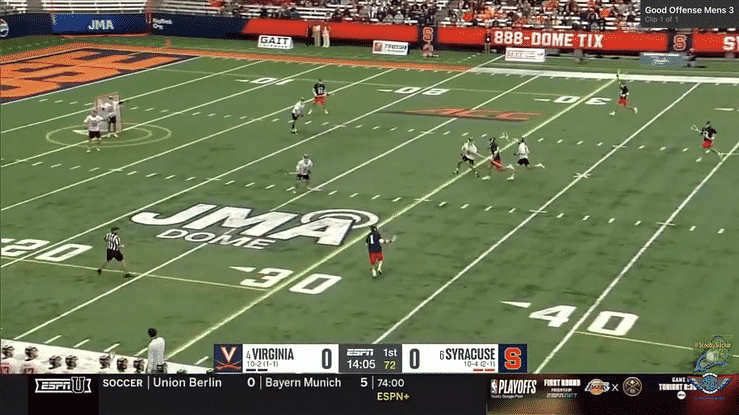
In the clip above, you see Virginia move the ball to the backside where they have a 3v2. The best part of this clip is the urgency of Virginia. By immediately stepping into the gap, they are able to capitalize just before Syracuse is able to get their last defender back on defense.
Fast Breaks
When it come to fast breaks, we are specifically talking about 4v3 opportunities. There are two types of standard breaks that teams use, but within them there are a few cue’s that can help increase your efficiency.
L Break
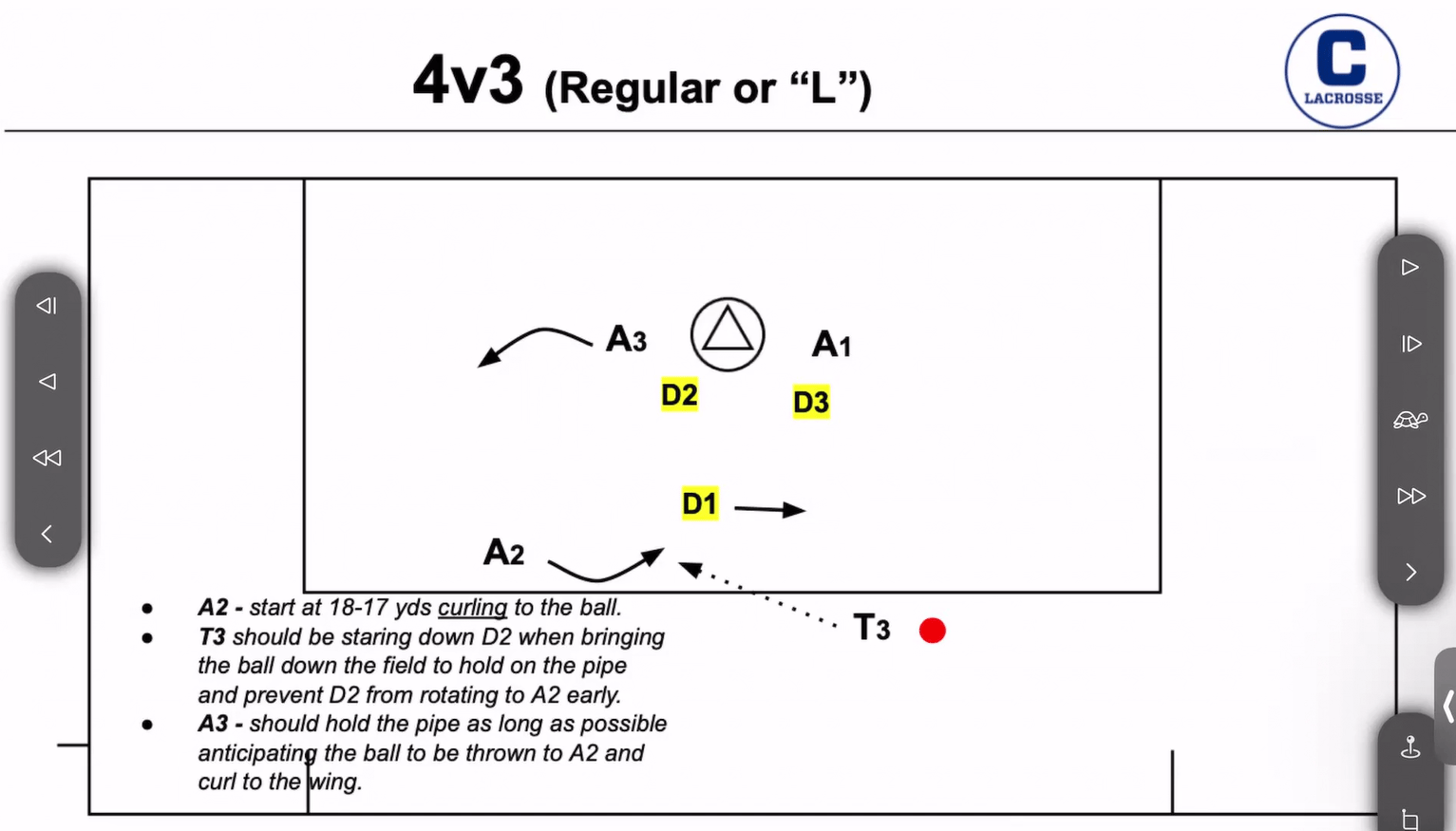
Source: Jake Bernhardt Webinar on FCL Online Community
The L break is the classic break that most players are taught first growing up. However there are some small nuances that can help your offense put more stress on the defense.
Keys to an L Break
First and foremost, the ball carrier must be a shooter first. He should be staring down the pipe defender looking to rotate to the point. By staring down this defender, and by being a shooter first, you accomplish two things:
You force the defense to respect the skip pass to the pipe, keeping the defense honest and unable to pre-rotate
You make the defense respect you. They need to stop your forward progress or risk giving up a lane to the goal
They next two keys to running the L Break are often missed.
The point man on the break wants to start high at around 15-18 (depending on level) yards above GLE, and they must curl in to the middle of the field. Their momentum should finish down and towards the center of the defense. This encourages the defense to be wider and play farther out then they should.
Lastly, the point side low attackman must start tight to the cage, and curl up and out to the wing. This keeps the defense honest, preventing them from rotating early.
By executing this curling motion before catching the ball, you create a much more challenging approach for the defense. Additionally, it gives you a better angle to shoot if the defense is slow to rotate, and it gives you a better passing lane to the backside.
Flat Break
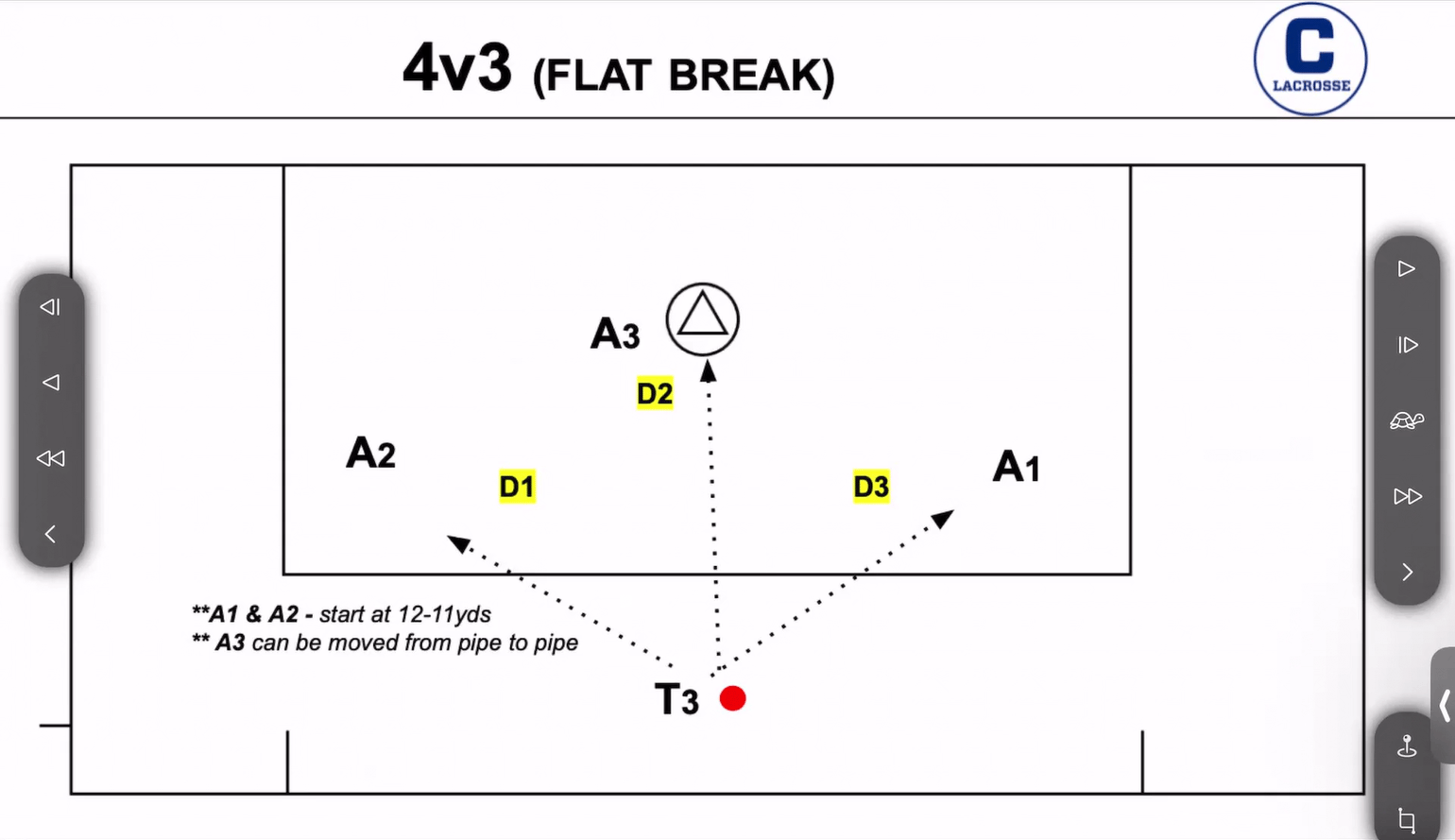
Source: Jake Bernhardt Webinar on FCL Online Community
The Flat break is the second type of formation the attack can set up in. Again with the flat break, the ball carrier should be to be a shooter first. The same cue’s apply here for the ball carrier as in the L Break.
Keys to a Flat Break
The two “point” attackman want to be standing about 11-12 yards above GLE.
Set up sufficiently wide so that the defense is forced to make a long slide or slide early
Be in a position where you are able to catch and shoot, this adds stress for the defense
The base attackman can be moved from pipe to pipe. Two key things to consider when deciding which pipe this player should be at:
If you have a great shooter on attack, consider placing the base attackman on the opposite pipe to lengthen the slide
Place the player on the side where they can catch the ball with their strong hand and stick to the outside
A crucial job that the base attackman must adhere to: They have backup responsibility. If a shot is taken, it is their job to run the ball out.
Slow Breaks
Slow breaks are basically any transition beyond an initial 4v3 fast break. They involve trailers coming into the mix and can blend into the “early offense” phase prior to settled 6v6.
As an offense, you have more than a few options for how to run these types of breaks. Teams often have rules like:
The ball carrier must cut the middle after moving it
The ball carrier must pass down pick down to start
As an offense, however you choose to run these types of breaks, the most crucial aspect’s are your spacing and hunting the 3v2. You typically want a hard cut to the middle and a trailer that lags the play to fill in any space vacated by the cutter.
5v4 Break
The 5v4 break is typically what we think of when we think of slow breaks. Again, there are plenty of different ways to run the 5v4. We will break down one such way.
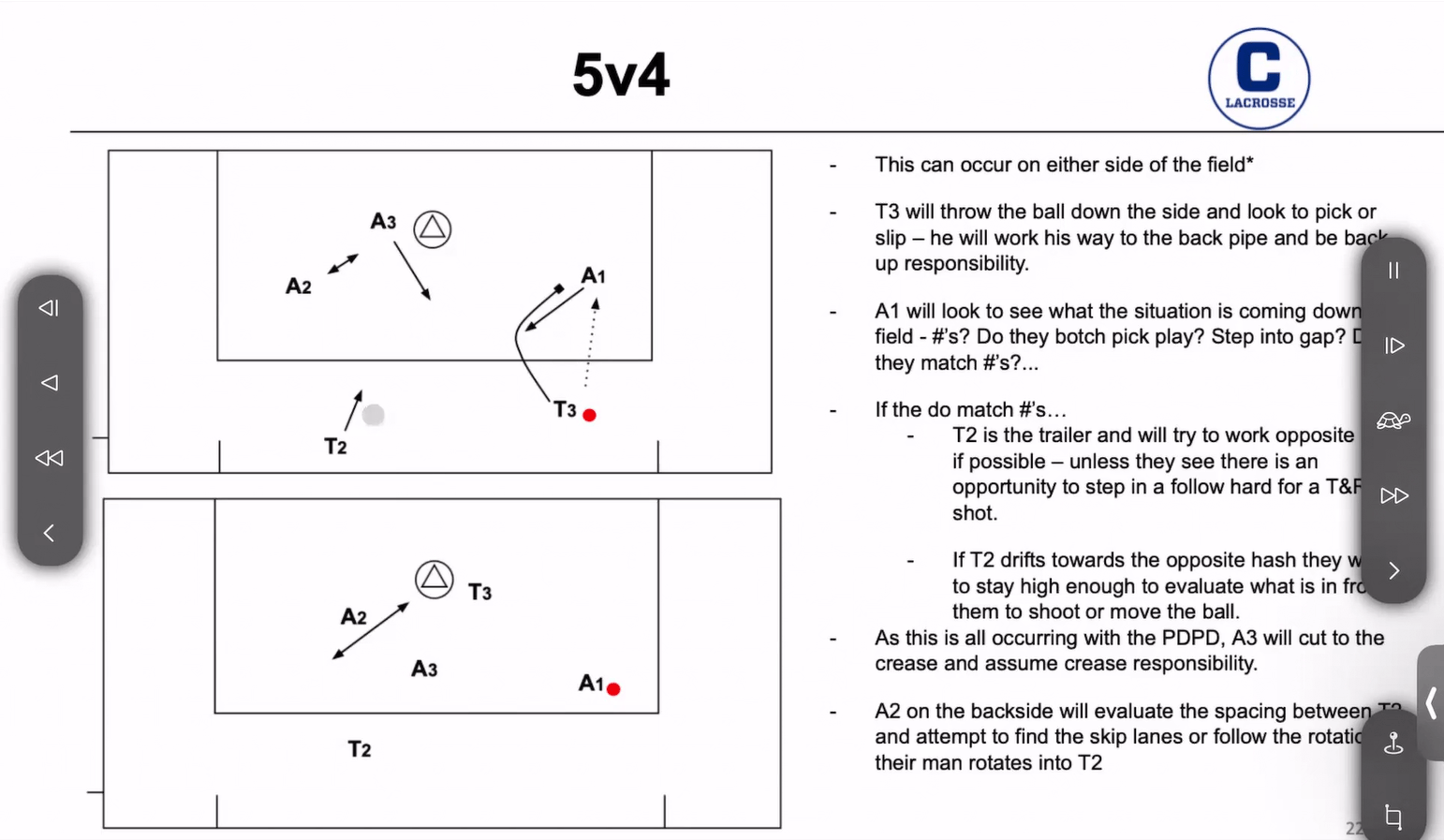
Source: Jake Bernhardt Webinar on FCL Online Community
When running a 5v4, the first thing to note is that the attack should set up in more of a flat break than an L break. Doing this opens up space in the middle of the field for trailers, and it opens up space to attack.
When the ball carrier moves the ball to the point attackman, he immediately enters a two man game with him. He has two responsibilities:
First, he is looking to pass down pick down, sell the pick and slip it, etc.
Second, the original ball carrier will become the backup responsibility. He must end up low enough to carry out this responsibility
The attackman coming out of this two man game must now take stock of the situation. Remember, we want to find the 3v2 as fast as possible, and move the ball to that spot. They should be scanning the field looking to answer these questions:
Is the defense matching numbers on the ball side?
Do we have a trailer coming down the field who is open?
Trailers coming down the field into this unsettled situation want to take stock of what the defense is doing as well:
Is there space to step into a shot in the middle of the field? If so, take it
If not, flow to the backside of the defense while staying high enough to read the defense
The last progression of this slow break is that the pipe attackman in the flat break will move up into the crease. It is important that they stay active on the crease:
This forces the defense to pack it in tight opening up the door for longer/late approaches
Remember that you are a scoring option, and if the defense does not respect that, take advantage of it
Wrapping It Up
When it comes to teaching transition, as a coach you want to empower your players to make good decisions. You want to team them the situational awareness of when to push vs when to slow it down. Questions like these are extremely important to consider when pushing transition:
How much defense did we just play?
Does the defense need a long possession to catch their breath?
What is the score and time remaining?
Remember that this is best learned through practice. Your players need a space to play fast, make decisions, and learn from the results (good or bad). It is something that you must be patient with.
Through consistent feedback, repetition, and freedom to make mistakes, your players will learn to make better choices and the execution will follow.
Until Next Time

Now that’s what we call a high quality shot.
Thanks for taking a trip down the hallway. If you are looking for a deeper dive, we have posted numerous videos on our Instagram, Twitter and YouTube channels on this topic.
Stay tuned for more content all spring and email us at [email protected] with any questions and let us know your thoughts.
What did you think of today's email?Contact us directly with more thoughts please! |
🚨 Webinar Freebie 🚨
This week’s freebie is from our webinar with Colby Head Coach Jake Bernhardt. Coach Bernhardt delivered a webinar on transition offense and drills. One drill we really liked was the Tank Drill. In this clip, Coach Bernhardt goes over how to set up the drill and talks through a live rep of the drill being run.
The FCL Circle community is the best resource on the market for any men’s or women’s coaching staff to continue developing through new drills and strategies. It includes over 30 college coach webinars, 100+ drills for offense, defense and full team compete.
🎥 WEBINAR FREEBIE: Defensive Settled Play Planning
🔦 COMMUNITY TOUR: Watch Community Tour Here.
🎙️ FCL PODCAST & COACH COMMUNITY
Want to keep sharpening your coaching toolbox?
🎧 Podcast – Check out our free podcast on Spotify, YouTube and Apple podcast. Who’s ready for season 2?
🔥 Online Community – For coaches who want to level up. Join our men’s and women’s coaching communities for in-depth webinars, drills, and strategy sessions with top college coaches.

